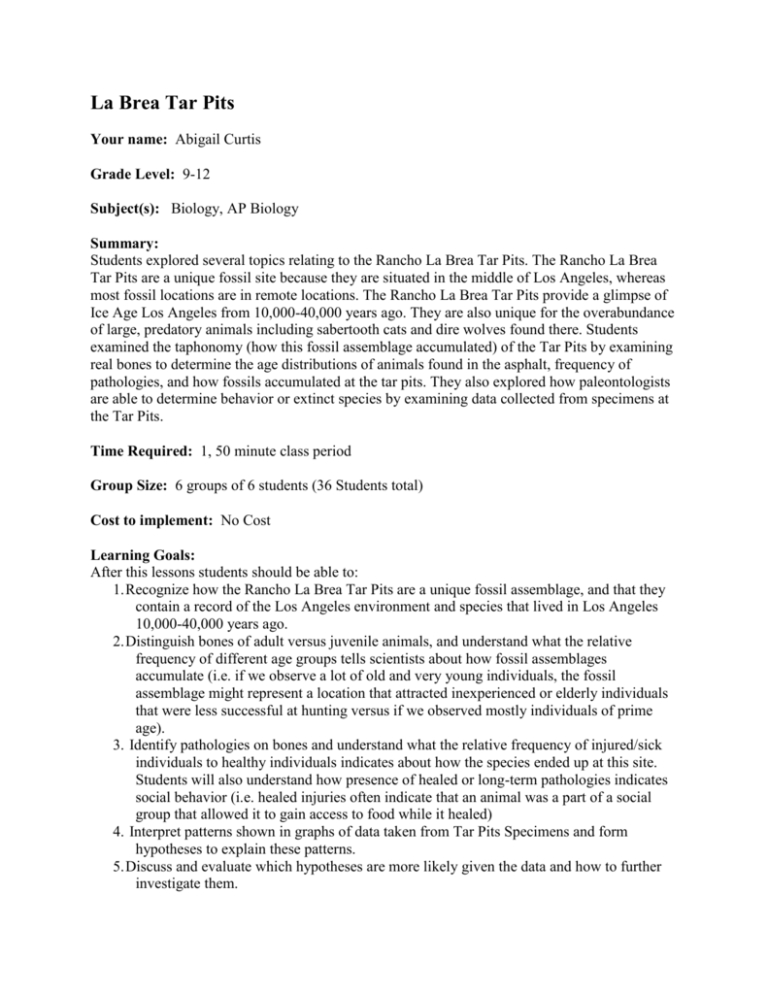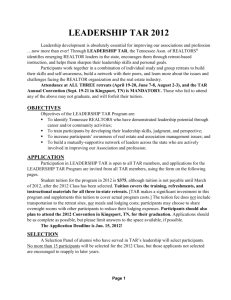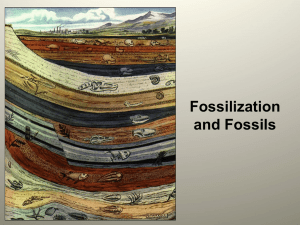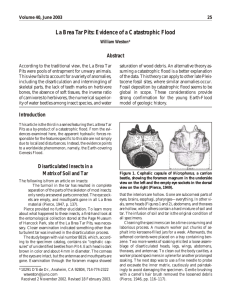Lesson Description
advertisement

La Brea Tar Pits Your name: Abigail Curtis Grade Level: 9-12 Subject(s): Biology, AP Biology Summary: Students explored several topics relating to the Rancho La Brea Tar Pits. The Rancho La Brea Tar Pits are a unique fossil site because they are situated in the middle of Los Angeles, whereas most fossil locations are in remote locations. The Rancho La Brea Tar Pits provide a glimpse of Ice Age Los Angeles from 10,000-40,000 years ago. They are also unique for the overabundance of large, predatory animals including sabertooth cats and dire wolves found there. Students examined the taphonomy (how this fossil assemblage accumulated) of the Tar Pits by examining real bones to determine the age distributions of animals found in the asphalt, frequency of pathologies, and how fossils accumulated at the tar pits. They also explored how paleontologists are able to determine behavior or extinct species by examining data collected from specimens at the Tar Pits. Time Required: 1, 50 minute class period Group Size: 6 groups of 6 students (36 Students total) Cost to implement: No Cost Learning Goals: After this lessons students should be able to: 1. Recognize how the Rancho La Brea Tar Pits are a unique fossil assemblage, and that they contain a record of the Los Angeles environment and species that lived in Los Angeles 10,000-40,000 years ago. 2. Distinguish bones of adult versus juvenile animals, and understand what the relative frequency of different age groups tells scientists about how fossil assemblages accumulate (i.e. if we observe a lot of old and very young individuals, the fossil assemblage might represent a location that attracted inexperienced or elderly individuals that were less successful at hunting versus if we observed mostly individuals of prime age). 3. Identify pathologies on bones and understand what the relative frequency of injured/sick individuals to healthy individuals indicates about how the species ended up at this site. Students will also understand how presence of healed or long-term pathologies indicates social behavior (i.e. healed injuries often indicate that an animal was a part of a social group that allowed it to gain access to food while it healed) 4. Interpret patterns shown in graphs of data taken from Tar Pits Specimens and form hypotheses to explain these patterns. 5. Discuss and evaluate which hypotheses are more likely given the data and how to further investigate them. Level of Inquiry: Students were engaged in guided inquiry throughout this lesson. They made their own observations from fossils and interpreted what they found. Students also examined graphs of data collected from the Tar Pits. They interpreted these data and came up with hypotheses to explain the data they were shown within their groups. Each group shared their hypotheses and as a class, we discussed which hypotheses were the best supported and how they could be further investigated. Introduction / Motivation: I polled the students to see how many have been to the tar pits and asked them what they knew about it. I then gave a brief introduction to the Tar Pits and the major species found there. Lesson Background Concepts for Teachers: Scientists gain a lot of important knowledge about what ancient ecosystems and organisms were like over the history of our planet by examining fossil assemblages. It is also important to understand how a fossil assemblage formed so that one is making correct interpretations of species interactions and behaviors. The Rancho La Brea Tar Pits are unique for their overabundance of mammalian carnivores, which are usually rare in ecosystems (think about the relative numbers of elk to wolves in Yellowstone National Park). Why are there so many carnivores in the Tar Pits? Was the ecosystem drastically different 10,000-40,000 years ago in Los Angeles than they are today? The best supported hypothesis for how the Tar Pits fossils accumulated is that a large herbivore would become mired in the asphalt, would call for help from its herd, which was essentially a dinner bell for the large social carnivores in the area who also became mired in the asphalt. This explains the overabundance of carnivores relative to herbivores, and is supported by experiments in modern ecosystems (Carbone, et al. 2009). One of the most exciting aspects of paleontology is trying to reconstruct how extinct animals behaved in their environments. Evidence, such as healed or chronic injuries or diseases can indicate that an organism lived in a group that allowed it to gain access to food while it was too weak to feed independently. Also, by examining what species are most commonly found at the Tar Pits and comparing them with modern analogues, it is possible to predict which species were animals were social versus solitary. This is what allowed scientists to conclude that sabertooth cats were social animals (Carbone, et al. 2009), even though there is only one living species of cat that is considered social (lions). Procedure: 1. Students will be introduced to basic information about the Tar Pits and share what they know about them. 2. Students will then examine bones from the Tar Pits to try to identify the age (juvenile vs. adult) of specimens, and discuss implications of understanding age structure in a fossil assembly. 3. Students will discuss modern ecosystems and the proportions of predators and prey and apply this knowledge to the fossil record. They will try to explain the unusually high proportion of predator specimens found at the RLB Tar Pits. 4. Students will examine specimens for pathologies and discuss what different types of pathologies signify (i.e. social behavior) 5. Students will look at the numbers of individual carnivore species at the RLB Tarpits and compare them with data from the African Savannah to test whether sabertooth cats were solitary or social. 6. Students will look at RLB fossils for post-mortem features, such as weathering, water damage, rodent gnaw marks, fragmentation, etc. This has implications for how long bones sat on the surface before they were buried in the asphalt. 7. Wrap-up to review what students learned and open time to look at fossils they didn’t get a chance to see fossils that aren’t at their table and some extra fragile specimens I am bringing in. Materials List Each pair of students will need: One fossil or image of a fossil One laptop to access google docs form, or printed form to fill out by hand Safety Issues: If students are working with real fossils, they need to be instructed on how to properly handle them. Lesson Closure: As a class, we reviewed what students discovered in class and took time for them to ask questions and observe specimens they didn’t get to see. Assessment: Throughout the lesson, I used a “Think, Pair, Share” model, where I posed questions to the students; they discussed it with a partner/group, and then shared their ideas with the class. We then discussed the students’ ideas together as a class. Students also entered their observations from real bones into a google docs form, which could be reviewed after the lesson. References: RLB Tar Pits: tarpits.org RLB and African Carnivore Data: Carbone, C. et al. 2009. Parallels between playbacks and Pleistocene tar seeps suggest sociality in an extinct sabertooth cat, Smilodon. Biology Letters. 5, 81-85. Attachments: Lesson Powerpoint: Winter Lesson.pptx Google Docs Form: Tar Pit Lesson Form.docx List CA Science Standards addressed: 8. Evolution is the result of genetic changes that occur in constantly changing environ- ments. As a basis for understanding this concept: a. Students know how to analyze fossil evidence with regard to biological diversity, episodic speciation, and mass extinction










